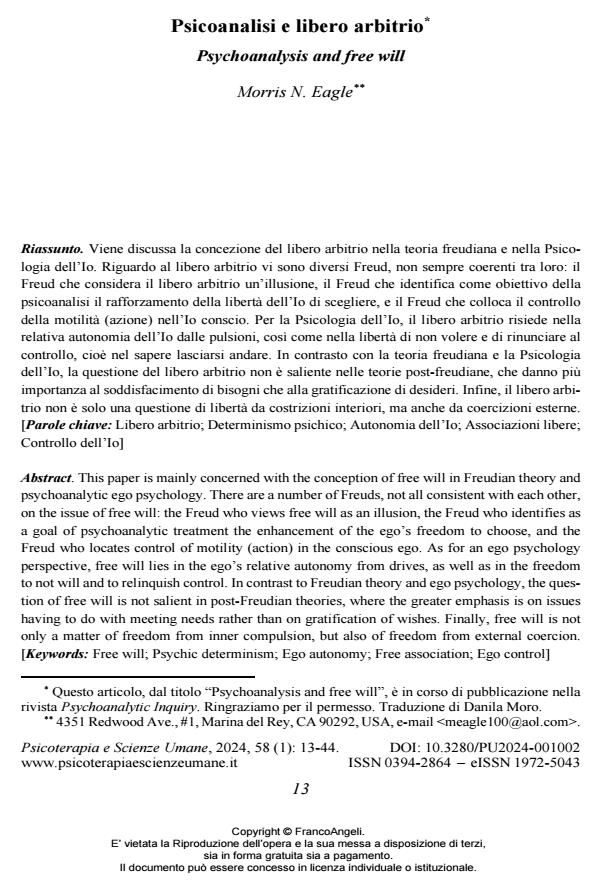Psicoanalisi e libero arbitrio
Titolo Rivista PSICOTERAPIA E SCIENZE UMANE
Autori/Curatori Morris N. Eagle
Anno di pubblicazione 2024 Fascicolo 2024/1
Lingua Italiano Numero pagine 32 P. 13-44 Dimensione file 167 KB
DOI 10.3280/PU2024-001002
Il DOI è il codice a barre della proprietà intellettuale: per saperne di più
clicca qui
Qui sotto puoi vedere in anteprima la prima pagina di questo articolo.
Se questo articolo ti interessa, lo puoi acquistare (e scaricare in formato pdf) seguendo le facili indicazioni per acquistare il download credit. Acquista Download Credits per scaricare questo Articolo in formato PDF

FrancoAngeli è membro della Publishers International Linking Association, Inc (PILA)associazione indipendente e non profit per facilitare (attraverso i servizi tecnologici implementati da CrossRef.org) l’accesso degli studiosi ai contenuti digitali nelle pubblicazioni professionali e scientifiche
Viene discussa la concezione del libero arbitrio nella teoria freudiana e nella Psicologia dell’Io. Riguardo al libero arbitrio vi sono diversi Freud, non sempre coerenti tra loro: il Freud che considera il libero arbitrio un’illusione, il Freud che identifica come obiettivo della psicoanalisi il rafforzamento della libertà dell’Io di scegliere, e il Freud che colloca il controllo della motilità (azione) nell’Io conscio. Per la Psicologia dell’Io, il libero arbitrio risiede nella relativa autonomia dell’Io dalle pulsioni, così come nella libertà di non volere e di rinunciare al controllo, cioè nel sapere lasciarsi andare. In contrasto con la teoria freudiana e la Psicologia dell’Io, la questione del libero arbitrio non è saliente nelle teorie post-freudiane, che danno più importanza al soddisfacimento di bisogni che alla gratificazione di desideri. Infine, il libero arbitrio non è solo una questione di libertà da costrizioni interiori, ma anche da coercizioni esterne.
Parole chiave:Libero arbitrio; Determinismo psichico; Autonomia dell’Io; Associazioni libere; Controllo dell’Io
Morris N. Eagle, Psicoanalisi e libero arbitrio in "PSICOTERAPIA E SCIENZE UMANE" 1/2024, pp 13-44, DOI: 10.3280/PU2024-001002